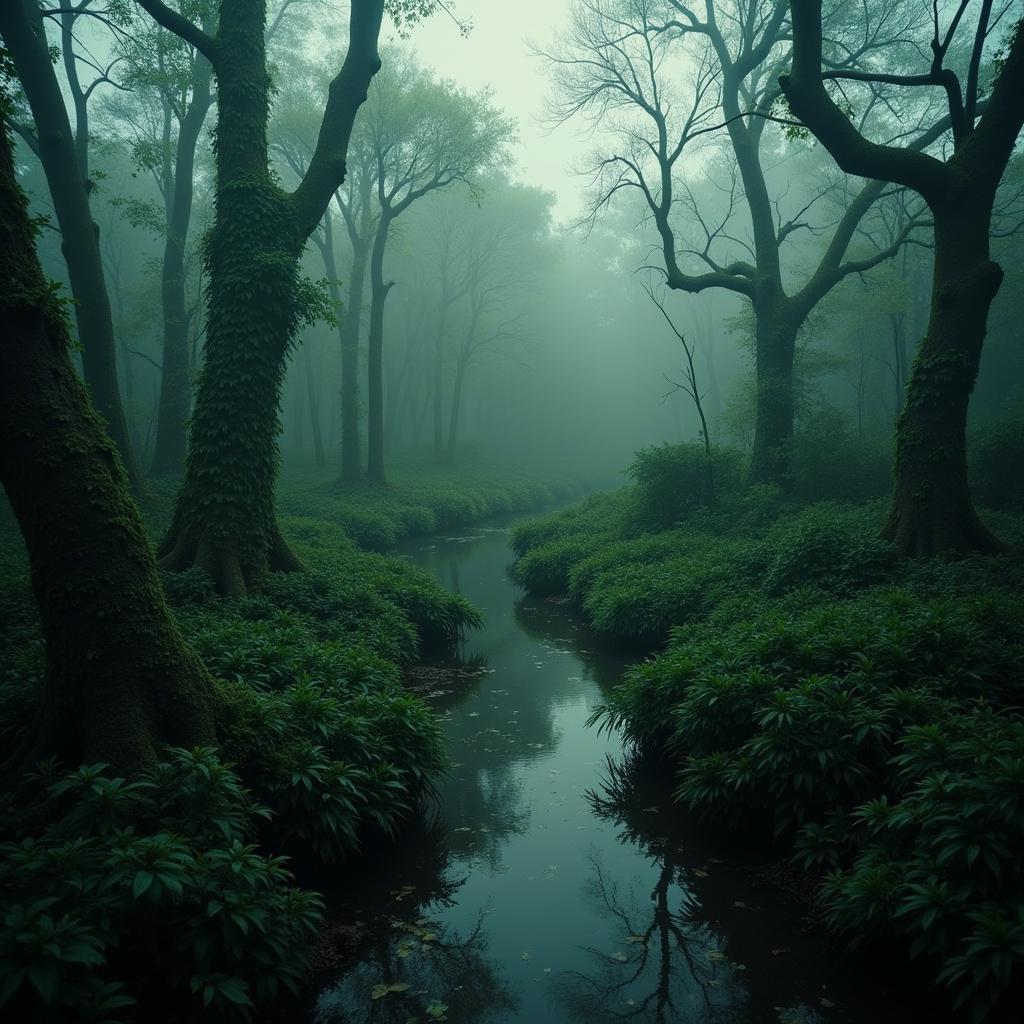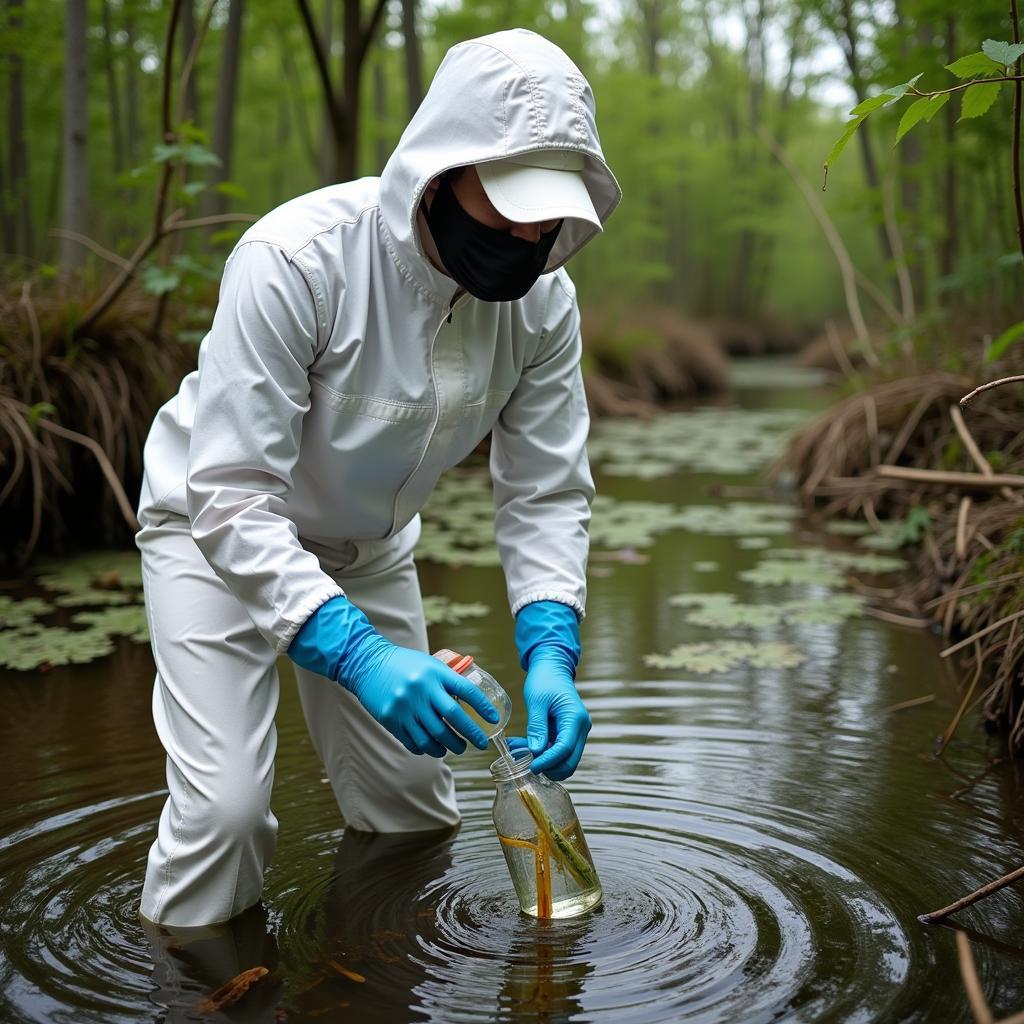The allure of the unknown has always drawn humanity to the edge of the map, and few places embody this sense of mystery more than noxious swamps. These murky, often treacherous wetlands, shrouded in mist and teeming with unseen life, have long been the subject of folklore, superstition, and, increasingly, serious scientific inquiry. “Noxious Swamp Research” delves into these enigmatic ecosystems, seeking to understand their unique biodiversity, their role in the global environment, and perhaps even the truth behind the legends that cling to them like morning fog.
 Aerial view of a dense, misty noxious swamp
Aerial view of a dense, misty noxious swamp
More Than Just Mud and Mosquitoes: The Importance of Noxious Swamp Research
While the term “noxious” might evoke images of disease-ridden backwaters, it’s crucial to understand that these ecosystems are far more complex and valuable than their reputation might suggest. Noxious swamps play a critical role in maintaining ecological balance. They act as natural filters, purifying water and preventing flooding. They are carbon sinks, absorbing and storing vast amounts of atmospheric carbon dioxide, which is essential in the fight against climate change. And they are biodiversity hotspots, home to a stunning array of plant and animal life found nowhere else on Earth.
 A researcher collects water samples in a noxious swamp
A researcher collects water samples in a noxious swamp
However, these vital ecosystems are under threat. Pollution, habitat destruction, and climate change are all taking a toll on noxious swamps around the world. This is why “noxious swamp research” is so critical. By studying these environments, scientists can learn how they function, how they are being impacted by human activity, and most importantly, how we can protect them for future generations.
Delving into the Unknown: Methods and Challenges
Researching noxious swamps presents unique challenges. The terrain is often difficult to navigate, the water can be deep and treacherous, and the abundance of insects can make fieldwork a less-than-pleasant experience. Despite these obstacles, researchers utilize a variety of techniques to study these fascinating ecosystems:
- Water Quality Analysis: Scientists collect water samples to assess factors like pH levels, dissolved oxygen content, and the presence of pollutants. This data helps determine the overall health of the swamp and identify potential threats.
- Biodiversity Surveys: From microscopic organisms to apex predators, noxious swamps are teeming with life. Researchers conduct meticulous surveys, often employing camera traps and other non-invasive methods, to catalog the species present and understand their complex interactions within the ecosystem.
- Sediment Core Sampling: Analyzing sediment layers deposited over time provides a historical record of the swamp’s environment, including changes in vegetation, water levels, and even past climate conditions.
These methods, combined with cutting-edge technology like remote sensing and GIS mapping, are providing scientists with an increasingly detailed understanding of noxious swamps and their importance to the planet’s health.
Beyond the Science: Folklore and the Paranormal
It’s impossible to talk about noxious swamps without acknowledging the air of mystery that surrounds them. For centuries, these wetlands have been the subject of countless folktales, often depicted as the domain of mythical creatures, spirits, and other supernatural phenomena. While science may offer rational explanations for many of these stories, the enduring power of folklore reminds us that some mysteries run deeper than our current understanding can fully explain.
Whether you’re a scientist seeking to unlock the secrets of a complex ecosystem, a nature enthusiast captivated by the beauty and biodiversity of these unique habitats, or simply someone intrigued by the enduring mysteries of the natural world, “noxious swamp research” offers a fascinating glimpse into a world often overlooked and underappreciated.
FAQs about Noxious Swamp Research
1. What is the most dangerous animal found in noxious swamps? While many people might assume it’s alligators or snakes, the most dangerous creatures are often the smallest. Mosquitoes and other biting insects can carry diseases that pose a significant threat to human health.
2. Are there any benefits to having noxious swamps near populated areas? Absolutely! They act as natural buffers against flooding, filter pollutants from water sources, and provide habitats for wildlife that can help control pest populations.
3. How can I get involved in noxious swamp research or conservation efforts? Many universities, research organizations, and conservation groups offer opportunities for volunteers to participate in fieldwork, data analysis, or educational outreach programs.
If you need further assistance, please contact us at Phone Number: 0904826292, Email: research@gmail.com or visit us at No. 31, Alley 142/7, P. Phú Viên, Bồ Đề, Long Biên, Hà Nội, Việt Nam. Our dedicated customer support team is available 24/7. You can also learn more about other intriguing topics like pokemon go noxious swamp field research or explore the wider world of pokemon go special research tasks.